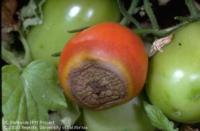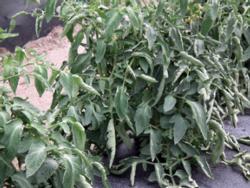Tomatoes, problems
-
Sometimes tomatoes have problems not caused by pests or diseases, but by cultural practices or the environment. Here is a description of the most common of these problems.
Blossom End Rot
Do your ripening tomatoes have a dark soft spot on the bottom of the fruit? Your tomato may have blossom end rot. Blossom end rot is a physiological disease that is caused by environmental conditions, not a microorganism. The disease is not associated with soil contact or with damage to other plant parts.Symtoms - Plants with blossom end rot show small, light brown spots at the blossom end of ripening fruit. The affected area gradually expands as the fruit ripens. It may also affect the inside of the fruit, either with or without external symptoms. It is caused by a low level of calcium in the fruit and water balance in the plant, mad worse by high soil salt and low soil mositure.
Solutions - Water consistently to keep the roots evenly moist but not soggy. Fertilize according to package instructions. Since the disease is not caused by a pathogen, pesticides are not effective.
Poor Fruit Set
Most people who raise backyard tomatoes have experienced the problem of poor fruit set. Under good conditions fruit set occurs normally, but tomato plants may fail to set fruit for any one of several reasons. Most causes of fruit set failure are environmental.The most frequent problems are:
-Cold nights in the spring
-High temperatures in the summer
-Low light intensity
-Smog (ozone)Prevention and Control of Fruit Drop
Cool nights When night temperatures fall below 55°F for several consecutive days, fruit set often fails. Under these conditions, fruit set can be improved with the use of fruit-setting hormones which are available in most retail nurseries or agricultural supply houses. Follow label directions carefully.Hot days When daytime temperatures consistently exceed 90°F, fruit set often fails. Some varieties are more tolerant of high temperatures and will continue to set fruit when others fail. Under these conditions, maintain constant moisture, monitor for pests, and control of diseases. Fruit-setting hormones are not effective in hot weather.
Low light intensity Tomato flowers may also fail to develop into fruit when there is not enough sunlight. Tomatoes prefer full sun for a minimum of 6 hours per day.
Smog Research has shown that high concentrations of ozone, a principal air pollutant during summer months, will significantly reduce fruit set in tomatoes. This is an unfortunate problem for which there is no solution at the present time. Read more about tomato fruit set failure. (See page 5)
Tomato Leaf Roll
Are the leaves on your tomato plant rolling up? Does the plant look wilted even though the soil is moist? Your tomato may have Tomato Leaf Roll.Symptoms - Firm and leathery leaves are common symptoms of tomato leaf roll; the lowest leaves roll upward in wet spring conditions. The tomato plant may look wilted.
Solutions - Tomato leaf roll symptoms disappear when temperatures become warmer and soils dry out. Normal growth resumes and there is no damage to the fruit that develop later. No action is required. Read more about tomato leaf roll. (See page 7)
Read more about other problems with tomatoes.


